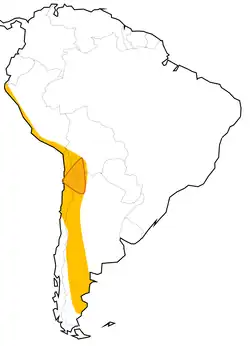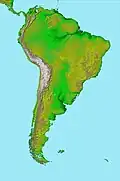Lithium Triangle
The Lithium Triangle (Spanish: Triángulo del Litio) is a region of the Andes that is rich in lithium reserves, encompassed by the borders of Argentina, Bolivia, and Chile.[1] The lithium in the triangle is concentrated in various salt pans that exist along the Atacama Desert and neighboring arid areas, the largest areas including Salar de Uyuni in Bolivia, Salar de Atacama in Chile, and Salar del Hombre Muerto in Argentina. Of those Salar de Atacama in Chile has the highest concentration lithium (0.15 % by weight) among all World's brine sources.

As of 2017 the area was thought to hold around 54% of the world's lithium reserves.[2] Nevertheless, these lithium reserves, which are the largest is size and the highest in quality in the World, are not expected to make the surrounding countries wealthy, as oil made Gulf Countries. For example, the total amount of lithium minerals in Chile is worth "less than Saudi Arabia's three years' worth of oil exports."[3]
According to The Economist Argentina was by November 2022 the country with most ongoing lithium extraction projects; in total 40.[4] By one estimate Argentina could displace Chile as the second largest lithium producer by 2027.[4] Similarly, there are estimates that posit Argentina producing 16% of the World's lithium by 2030, instead of the 6% it produced in 2021.[4] Low royalty payments when compared to Chile are cited by The Economist as a particular advantage.[4]
In December 2018 Bolivia signed an agreement with the German company ACISA for lithium extraction.[5] The cooperation with ACISA was however by June 2022 deemed to have stalled with Bolivia negotiating instead larger lithium projects with Canadian, Chinese and United States companies.[5] Since the early 2020s, the Bolivian government has been advocating that the countries in the region organize themselves so that they can influence international trade of lithium, including the creation of an organization similar to OPEC.[6]
All lithium extracted in Chile as of 2023 comes from Salar de Atacama.[7] The only two lithium-extracting companies currently operating in Chile, SQM and Albemarle, have licences to extract lithium until 2030 and 2043 respectively.[7][8] In April 2023 Chilean government announced plans for nationalizing its lithium industry.[9] The announcement impacts chiefly the companies SQM and Albemarle.[9] In response, the shares of SQM in the Santiago Stock Exchange dropped by 15% during the day, their largest daily drop since September 20, 2022.[10] The government's decision was thought to have less impact for Albemarle than for SQM given that it had many more years to negotiate before its licence expire.[8] The state-owned copper company Codelco was commissioned by the government to negotiate nationalization with SQM.[8]
The indigenous inhabitants of Salar de Atacama basin –the Likan Antay– have a history of both opposing lithium extraction and negotiating for shared benefits with lithium companies.[11] Negotiations occur under the framework of the Indigenous and Tribal Peoples Convention which Chile signed in 2008.[11] It is argued that "[a]greements between Indigenous organizations and lithium companies have brought significant economic resources for community development, but have also expanded the mining industry's capacity for social control in the area."[11]
See also
References
- Anlauf, Axel (2016). "Greening the imperial mode of living? Socio- ecological (in)justice, electromobility, and lithium mining in Argentina". In Pichler, Melanie; Staritz, Cornelia; Küblböck, Karin; Plank, Christina; Raza, Werner; Ruiz Peyré, Fernando (eds.). Fairness and Justice in Natural Resource Politics.
- Ellsworth Dickson (2017). "South America's prospective - The Lithium Triangle". Resource World. Retrieved 7 December 2019.
- Lithium: The Global Race for Battery Dominance and the New Energy Revolution. 2021. L. Bednarski. ISBN: 1787386732 . p. 97. https://oceanofpdf.com/authors/lukasz-bednarski/pdf-epub-lithium-the-global-race-for-battery-dominance-and-the-new-energy-revolution-download/?id=000715884250
- "Argentina could help the world by becoming a big lithium exporter". The Economist. 15 November 2022. Retrieved 21 April 2023.
- "Bolivia: el sueño alemán del litio amenaza con derrumbarse". Deutsche Welle (in Spanish). 13 June 2022. Retrieved 20 April 2023.
- "Hacia una Organización Latinoamericana de Países Exportadores de Litio (OLPEL)". CELAG (in Spanish). 23 May 2022. Retrieved 26 March 2023.
- Munita C., Ignacia (21 April 2023). "Control estatal de los salares, negociar con SQM y empresa nacional: Las claves de la estrategia del Gobierno por litio". Emol (in Spanish). Retrieved 21 April 2023.
- Browne R., Vicente (21 April 2023). "Las razones del desplome bursátil de SQM tras el anuncio presidencial del litio". Ex-Ante (in Spanish). Retrieved 21 April 2023.
- Villegas, Alexander; Scheyder, Ernest (21 April 2023). "Chile plans to nationalize its vast lithium industry". Reuters. Retrieved 21 April 2023.
- Pescio, Benjamín; Arvelo, María C. (21 April 2023). "Acción de SQM se desploma por política del litio y borra más de US$ 3.300 millones en capitalización bursátil". Diario Financiero (in Spanish). Retrieved 22 April 2023.
- Lorca, Mauricio; Olivera Andrade, Manuel; Escosteguy, Melisa; Köppel, Jonas; Scoville-Simonds, Morgan; Hufty, Marc (2022). "Mining indigenous territories: Consensus, tensions and ambivalences in the Salar de Atacama". The Extractive Industries and Society. 9: 101047. doi:10.1016/j.exis.2022.101047. S2CID 246456703.
Bibliography
- Dube, Ryan (10 August 2022). "The Place With the Most Lithium Is Blowing the Electric-Car Revolution" [El sitio con más litio está perdiéndose la revolución de los carros eléctricos]. The Wall Street Journal. CCLXXX (35). ISSN 1042-9840. Retrieved 11 August 2022.
External links
 The dictionary definition of lithium triangle at Wiktionary
The dictionary definition of lithium triangle at Wiktionary
